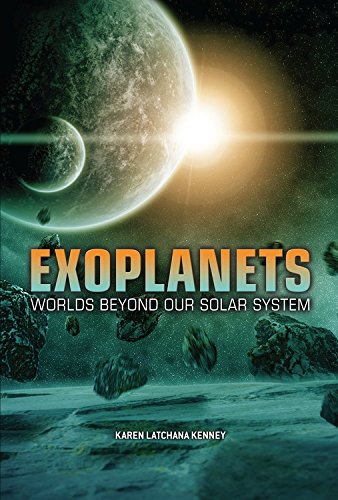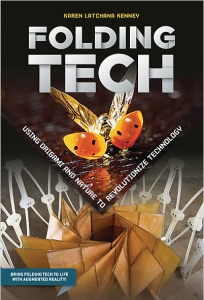Folding Tech: Using Origami and Nature to Revolutionize Technology. Twenty-First Century Books, LernerPublishing, 2020
**Junior Library Guild selection**
“Effectively showcases the contemporary brilliance that can come from ancient principles.”—Kirkus Reviews, 1 September 2020
“From folded cranes to collapsible solar sails, this offering provides an enticing look at a unique STEAM crossover.”—Booklist, 15 October 2020
Extreme Longevity: Discovering Earth’s Oldest Organisms. Twenty-First Century Books, Lerner Publishing, 2018**Junior Library Guild selection**
“Immortality may still be the stuff of legend for humans, but it’s a real possibility for a jellyfish native to the Mediterranean Sea. Biologists are studying specimens of flora and fauna that live extraordinarily long lives. The longest living human on record is Jean Louise Calment, a Frenchwoman who lived 122 years and 164 days, but that’s nothing compared to the Greenland shark that may live over 500 years. In an accessible, informative text, Kenney (Healing Plants, 2018, etc.) introduces biologists and geneticists who study examples of extreme longevity in the plant and animal kingdoms, such as the possibly 80,000-year-old root system of a colony of male quaking aspens. . . . Useful for reports or reading for pleasure, this is an engaging and informative volume. An intriguing look at some of world’s oldest organisms and the scientists who study them.” —Kirkus, July 30, 2018
“A fascinating study of some of the longest-living organisms on the planet. Although many books cover the life of various plants and animals, this particular approach is thought-provoking and awe-inspiring. If we think of a standard human lifespan and then lengthen it by 20 years, most people would consider those centenarians to be truly old. Readers learn that there are many mammals, fish, reptiles and other smaller organisms that make our human lives seem like drops in an eternal bucket. Simply to imagine a bowhead whale’s journey through icy Arctic waters, encountering whalers from the 1890s and then scientists from 2017, connects humans to our past as never before: human beings are merely one small component of time and Earth. The chapters are well written and succinct. Fascinating segments offer additional information, enhance the narrative, and will engross readers. Each chapter is a topic unto itself and offers scientific as well as anecdotal material. VERDICT An excellent addition to middle school and high school library collections.“–School Library Journal, January 1, 2019
Super Hummingbirds. Jump! 2018
(Super Chameleons) **Junior Library Guild selection**
STARRED REVIEW: “This zippy book lives up to its series’ name, Nature’s Superheroes (4 titles), as Kenney presents a variety of awe-inspiring, “super” hummingbird facts. Hummingbirds’ abilities, such as flying backward, are presented as “powers,” which feels exciting but not hyperbolic, because facts carefully support each assertion. Some of the details, such as how these tiny creatures move their wings in a figure-eight pattern or use their feet only to perch, not walk, may surprise even adult readers. The facts are not only interesting but also well integrated. Short, simple sentences flow together easily to build larger ideas. Beautiful close-up photos on every spread add a sense of immediacy and focus, and a helpful diagram labels the bird’s main features. . . . This book makes learning about nature wondrous and engaging for both children and adults.” —Booklist, March 2018

Exoplanets: Worlds Beyond Our Solar System. Twenty-First Century Books, Lerner Publishing, 2017
**Junior Library Guild selection**
“Perfect for outer space enthusiasts and out of this world for report writers.” —School Library Journal, January 2017
“An enticing overview of tools, techniques, and discoveries in what the author rightly characterizes ‘a red-hot field in astronomy.’ Readers curious about how researchers could possibly detect such dinky, distant objects as planets belonging to other star systems will come away satisfied and intrigued.”—Kirkus, March 1, 2017
“An excellent resource for Earth science teachers, Exoplanets addresses the history of our search for other planets, the amazing tools that scientists have developed to conduct that search, and some of the planetary discoveries made in recent years. . . The book provides an interesting and concise overview of our present knowledge of exoplanets and where scientists will focus their efforts in the future as they search for life in the universe.” —National Science Teachers Association Recommends, September 2017

You Have a Pet What?!: Rat and Sugar Glider. Rourke, 2015
STARRED REVIEW: “After flipping through the utterly adorable full-color photos of cute creatures in the You Have a Pet What?! series, youngsters might want to ditch their doggies and rush to their nearest exotic-pets breeder. . . . Sugar Glider doesn’t soften the realities of owning these delicate creatures: they require several hours of active attention per night. . . . there are enough fascinating and informative facts to keep readers enthralled. HIGHLY RECOMMENDED.”—Booklist, August 2015

Everything World War I. National Geographic Kids, 2014
STARRED REVIEW: “Kenney, along with historian Edward G. Lengel, introduces middle grade students to the key events and major characters of the first modern war in the 20th century. Filled with color and b&w maps, infographics, and behind-the scene photos, the book covers the events that led to war, battlefields, the home front, major personalities, and a reflective afterword which includes an interactive glossary and websites for additional investigation. One of the highlights of this book is the sidebar panels that feature various medals of valor, headgear fashion, and animal soldiers. The panel graphics are so clear and concise, it almost looks as if the reader can touch them and feel the textures and depth. This volume can be read for enjoyment by war enthusiasts, by reluctant readers who prefer nonfiction, and in grade level curriculum. HIGHLY RECOMMENDED“—Sabrina Carnesi, Library Media Connection, March/April 2015


